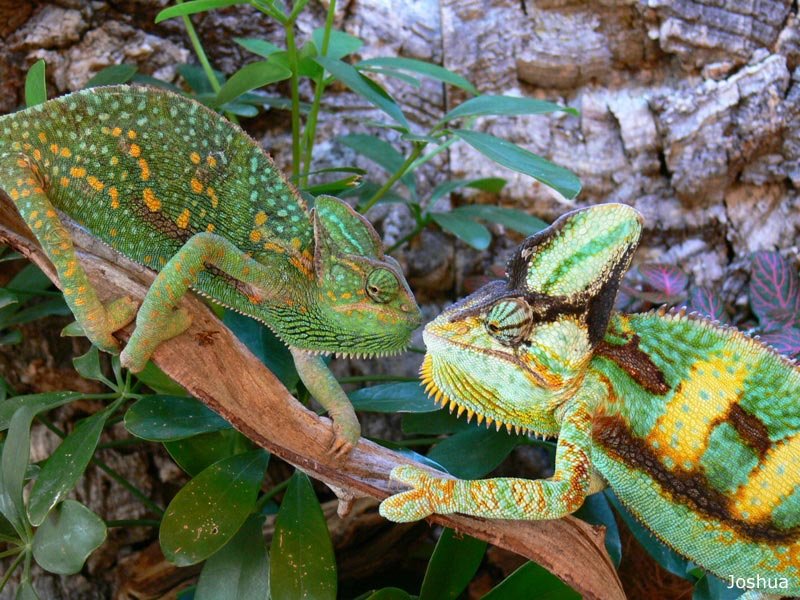
Here’s the thing: while reptiles can often share a space, not all species get along. In the wild, veiled chameleons are solitary creatures. They like their space and may not appreciate a new roommate snatching up their basking spot or invading their territory. Let’s dive deeper into whether these colorful critters can coexist peacefully with their scaled friends.
Understanding Veiled Chameleons
Veiled chameleons, native to Yemen and Saudi Arabia, are admired for their ability to change color and blend into their surroundings. They’re also known for their unique personalities and behaviors. These reptiles can grow to be quite large, reaching lengths of up to 24 inches, with males typically being bigger than females.
You might find their long, sticky tongues fascinating. They can shoot out their tongues at lightning speed to catch prey. This impressive feature is just one part of what makes veiled chameleons special. However, their individual needs and temperament play a huge role in how they interact with other reptiles.
Speaking of temperament, veiled chameleons can be territorial. They like to have their own space and don’t usually appreciate the intrusion of other reptiles. So, before you think about introducing a new friend into their habitat, it’s important to know what you’re dealing with.
Do Veiled Chameleons Tolerate Companionship?
When it comes to reptiles, social dynamics can be tricky. While some species are more communal, veiled chameleons prefer solo living. Keeping them with other reptiles can lead to stress for both parties. Imagine sharing a tiny apartment with someone who dislikes your music—it’s just not going to work out.
If you decide to house a veiled chameleon with another reptile, like a bearded dragon or a leopard gecko, you may run into some challenges. These species have different care requirements and temperaments, which could lead to competition for resources like food and basking spots. Most importantly, different reptiles can carry different bacteria, so introducing one to another can lead to health risks.
So, can veiled chameleons tolerate companionship? Typically, it’s best to err on the side of caution and keep them alone. If you still want a mixed-reptile environment, careful planning and consideration of each species’ needs are essential.
Housing Considerations for Veiled Chameleons
Creating a suitable habitat for your veiled chameleon is crucial for their health and happiness. A tall terrarium is ideal, as they love climbing. You’ll want to include branches, plants, and plenty of hiding spots. The more natural the environment, the more comfortable they’ll feel, which might reduce any territorial behavior.
When it comes to temperature, veiled chameleons need a basking spot of about 85-95°F (29-35°C), with cooler areas down to 70°F (21°C). They also require a UVB light to stay healthy. If you introduce other reptiles into this habitat, their specific light and heat needs may differ. This mismatch can stress your chameleon and lead to health issues.
You also have to think about feeding. Veiled chameleons are insectivores, requiring a diet of crickets, roaches, and worms. Meanwhile, other reptiles may prefer different types of food, potentially causing competition during feeding times. Having two different diets in a shared space can complicate things, adding another reason to think twice before mixing species.
Stress Indicators in Veiled Chameleons
So, how do you know if your veiled chameleon is feeling stressed? They can’t exactly tell you, but there are signs to look for. A stressed chameleon might display darker colors or an inflated body as a warning. They may also refuse food or become lethargic.
If you notice these changes, it might indicate that your chameleon is feeling threatened or uncomfortable in its environment. They could be reacting to the presence of other reptiles, or perhaps the habitat isn’t meeting their needs. If you see these signs, it’s crucial to take action—whether that means relocating your chameleon or making adjustments to their habitat.
In some cases, introducing new reptiles can lead to aggressive behaviors. If you see your chameleon hissing, puffing up, or even trying to bite, it’s time to separate them from the other reptiles for their safety and well-being.
Alternatives to Mixed Species Habitats
If you’re set on creating a diverse reptile environment, consider alternative solutions. Rather than mixing species, you could have separate enclosures side by side. This way, your veiled chameleon can still see other reptiles without direct interaction. Think of it as having neighbors—you can wave to them but still enjoy your own space.
Another option is to focus on a single-species habitat. For instance, if you have multiple veiled chameleons, you can create a more populated but still harmonious environment. Keeping like species together helps reduce stress and makes for a happier home.
Finally, if you want to expand your reptile family, do thorough research on each species’ needs. Understanding the differences can help you make informed decisions and keep your pets as healthy and happy as possible.
In the end, veiled chameleons can be beautiful pets, but they thrive best on their own. While you might want to introduce them to other reptiles, it’s essential to consider their needs and behaviors. Remember, each reptile has its unique personality, and not everyone gets along with others.
Taking a thoughtful approach is key. If you want a diverse reptile collection, keeping them separate or focusing on same-species habitats is often the best route. Ensuring all your pets are happy and healthy means doing your research and being a responsible owner.
So, whether you choose to keep a solo veiled chameleon or create a broader reptile environment, your care and attention will help them thrive. Happy keeping!

